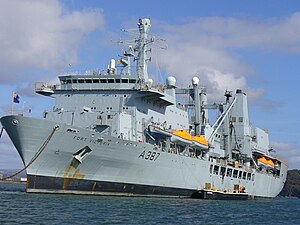Fort Victoria-class replenishment oiler
This article needs additional citations for verification. (June 2008) |
 Fort Victoria
| |
| Class overview | |
|---|---|
| Name | Fort Victoria class |
| Builders |
|
| Operators | |
| Built | 1988–1991 |
| In commission | 1993– |
| Planned | 6 |
| Completed | 2 |
| Cancelled | 4 |
| Active | 1 |
| Scrapped | 1 |
| General characteristics | |
| Class and type | Replenishment oiler |
| Displacement | 32,300 long tons (32,818 t) full load |
| Length | 203 m (666 ft 0 in) |
| Beam | 30 m (98 ft 5 in) |
| Draught | 10 m (32 ft 10 in) |
| Propulsion | 2 shafts, Crossley-Pielstick V-16 diesels, 23,904 bhp (17,825 kW) |
| Speed | 20 knots (37 km/h; 23 mph) |
| Complement | 95 RFA / 15 RN / 154 FAA / 24 RNSTS civilians |
| Sensors and processing systems |
|
| Electronic warfare & decoys | |
| Armament | |
| Aircraft carried | Up to 5 × Sea King or Merlin helicopters (3 in hangar) |
The Fort Victoria or Fort II class is a class of replenishment oiler of the Royal Fleet Auxiliary, a role that combines the missions of a tanker and stores supply ship.[2] As such they are designated auxiliary oiler replenisher (AOR). They are tasked with providing ammunition, fuel, food and other supplies to Royal Navy vessels around the world. There were two ships in the class, Fort Victoria and Fort George; the latter being taken out of service and despatched for scrapping at a Turkish breakers as a consequence of budgetary cutbacks.
History[]

Six ships were initially planned to supply the Type 23 frigates in their North Atlantic anti-submarine role. The Type 23 was at the time planned to be a low cost, lightly armed vessel and the Fort-class ships were therefore expected to defend themselves with the Sea Wolf vertical launch surface-to-air missile (SAM).
The lessons of the Falklands War meant the Type 23 developed as a much more potent, multi-role vessel carrying the Sea Wolf missile.[3][4][5] The requirement for the Fort class was reduced from six to two.
Fort Victoria was built by Harland and Wolff and Fort George by Swan Hunter and the ships entered service in 1994 and 1993 respectively.[6] Fort Victoria was delayed when she was bombed by the IRA on 6 September 1990 and nearly sunk.[7]
Class details[]
| Name | Pennant | Builder | Ordered | Laid down | Launched | Commissioned | Fate |
|---|---|---|---|---|---|---|---|
| Fort Victoria | A387 | Harland and Wolff, Belfast/Cammell Laird[6] | 23 April 1986[6] | 4 April 1988[6] | 12 June 1990[6] | 24 June 1994, under "assisted maintenance" at Rosyth Dockyard[6] | Active as of 2021 |
| Fort George | A388 | Swan Hunter, Wallsend-on-Tyne[6] | 18 December 1987[6] | 9 March 1989[6] | 1 March 1991[6] | 16 July 1993[6] | Decommissioned April 2011 Scrapped 2013 |
See also[]
- Fort Rosalie or Fort I class RFA replenishment ships
Notes[]
- ^ "New navigation radar system for Royal Navy". Government of the United Kingdom. 28 January 2016. Retrieved 20 August 2020.
- ^ "RFA Fort Victoria". Royal Navy. Retrieved 22 December 2011.
- ^ McLain, Lynton (10 July 1987). "Design Changes Add £90M To Cost Of Frigate". Financial Times.
- ^ Donne, Michael (9 June 1984). "BAe wins MoD contract to develop Seawolf missile". Financial Times.
- ^ Grove, Eric (September 1987). "The Royal Navy Sails Into Tomorrow". Defense & Foreign Affairs.
- ^ a b c d e f g h i j k Jane's Fighting Ships, 2004-2005. Jane's Information Group Limited. p. 818. ISBN 0-7106-2623-1.
- ^ From an interview with shipbuilder Sir John Parker published by Sunday Times, 13 March 2006: :The contract for Fort Victoria was won, but the ship became a target for the IRA. "She was afloat in the dock when we got the call from the IRA. Later that day the bomb went off and blew a hole in the engine room of the ship. The ship heeled over to about 45 degrees and we thought we were going to lose her. Fortunately some very courageous engineers went on board and lowered pumps in to clear the engine room so we could save the ship." The next day there was a call about a second bomb. It took two weeks to find it and make it safe – valuable time lost. Such incidents moulded Sir John and taught him patience and resolve, the like of which is rare in many boardrooms.
Bibliography[]
- Beaver, Paul, Britain's Modern Royal Navy, Patrick Stephens Limited, 1996, ISBN 1-85260-442-5
External links[]
Fort class replenshipment ships at the Royal Navy website
- Auxiliary replenishment ship classes
- Fort Victoria-class replenishment oilers
- Auxiliary ships of the United Kingdom
